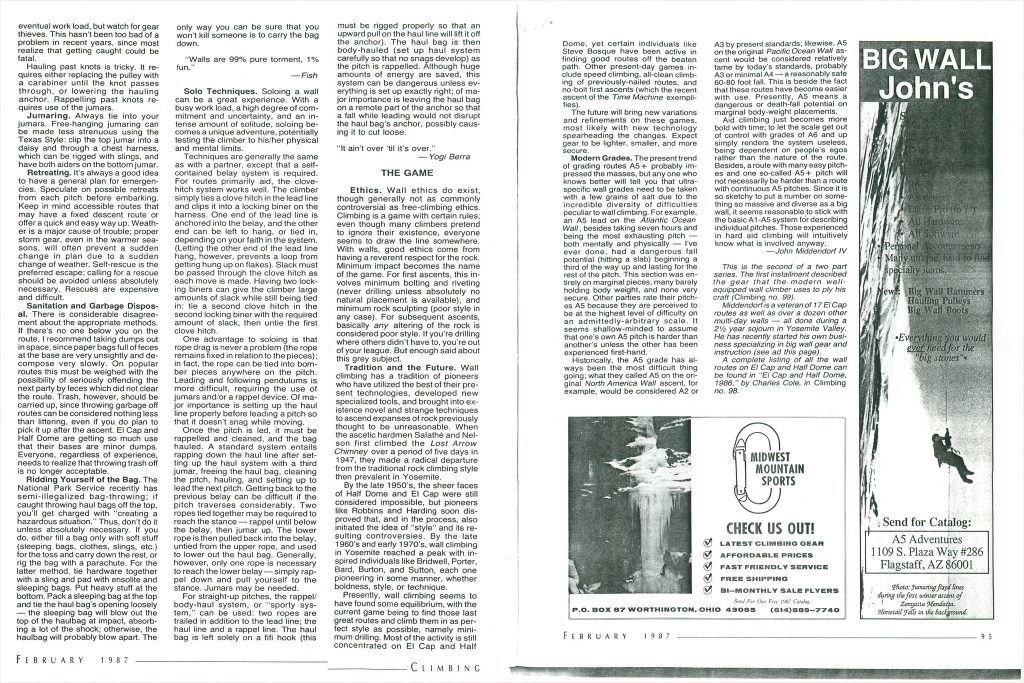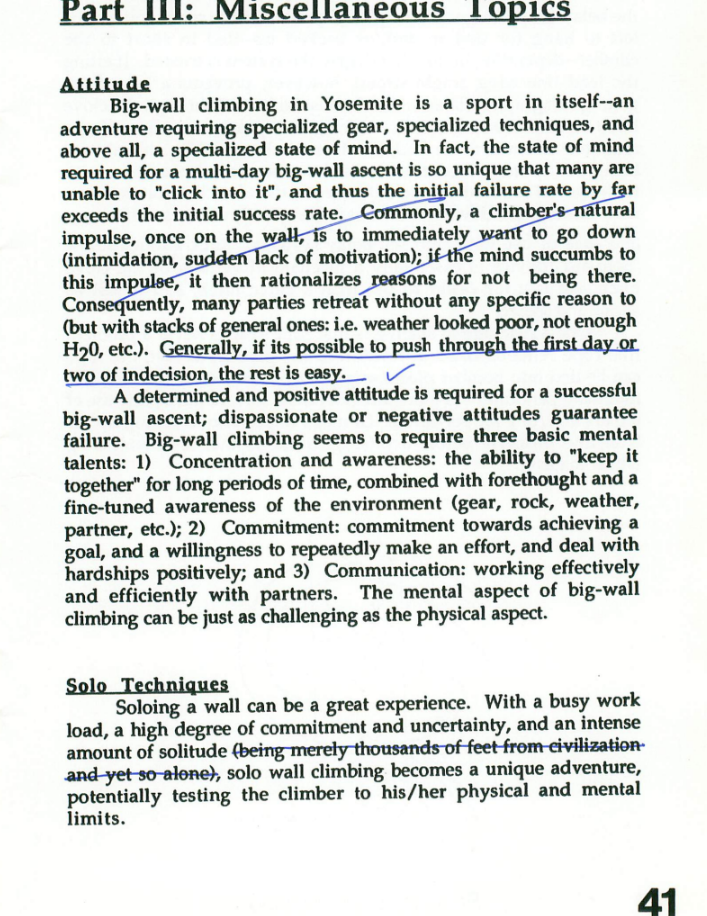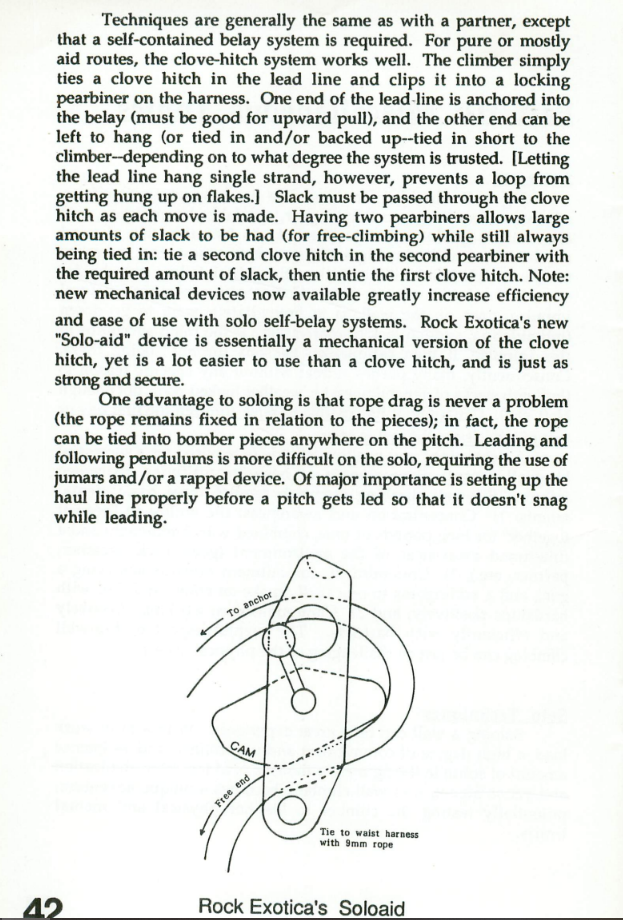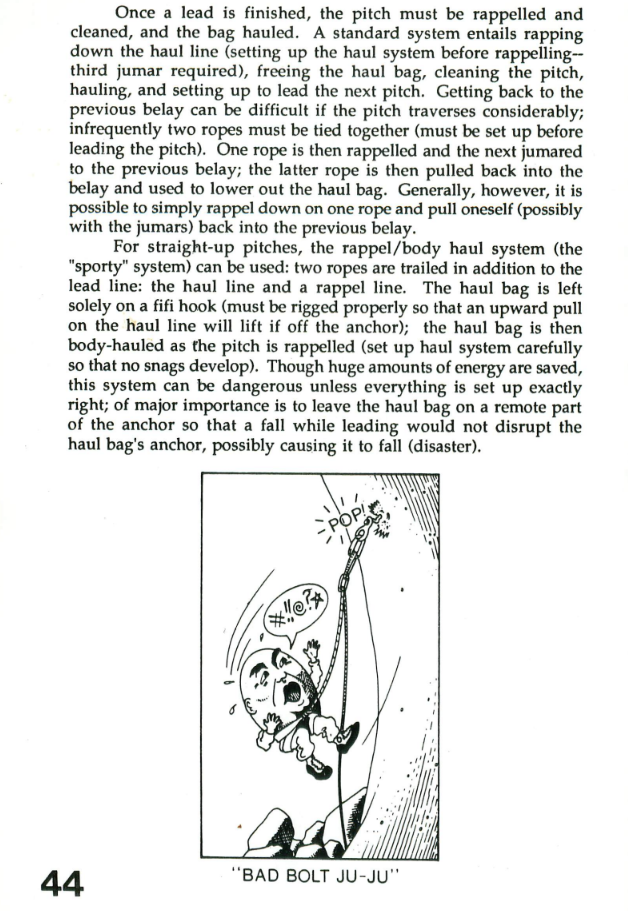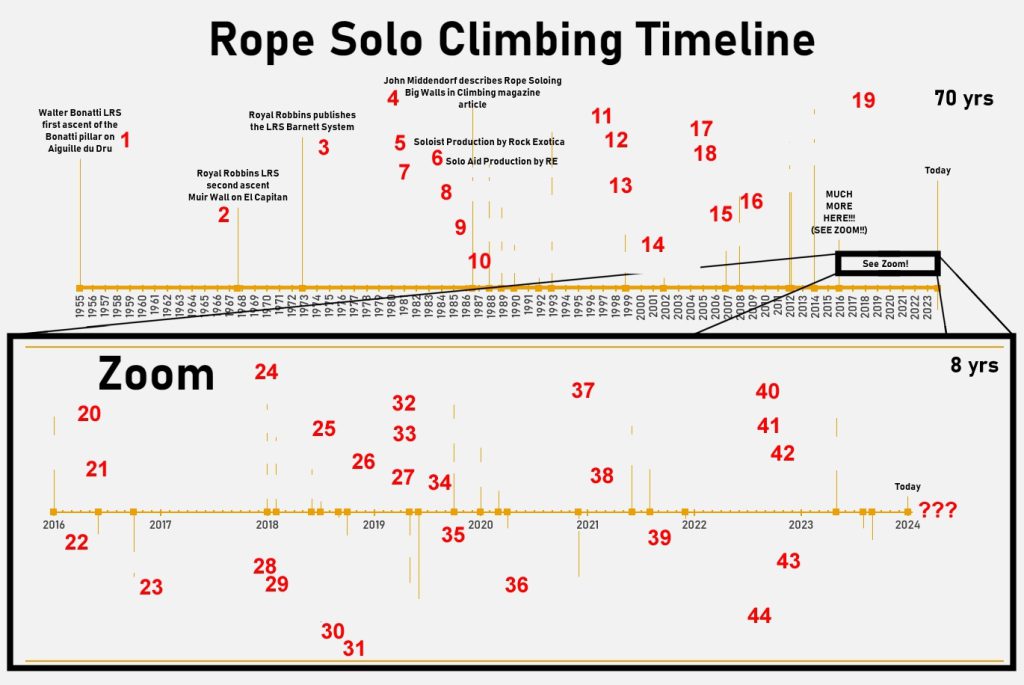Rope Solo – Landmark Event #4 – 1987 – John Middendorf Describes Rope Soloing Big Walls in Climbing Magazine Article
With only a bit over 200 words, it packs lots of information!!
- Using a running clove hitch
- How to back it up or not
- Using two hitches
- Rope snags
- No rope drag
- Challenge of pendulums
- Rappel line option
- Haul line option
- Fifi haul and specific risks
Most of the images below are from John and you can find them and more here.
Feb 1987 issue of Climbing Magazine:
Then Big Wall Tech Manual by John Middendorf, illustrations by John McMullen and published by A5 Adventures. (Thank John for sharing these copies!!)
[2024-05-01 EDIT] Note that when John Middendorf figured out the double clovehitch system circa 1983, he was able to do the third solo ascent of the Shield in record time in 1984. He also climbed the first solo of Never Never Land in 1985. Some great information can be found here.
[2024-06-23 EDIT] Super sad to write that John Middendorf passed away from a Stroke suffered during his sleep. Read a great article about John here. My condolences to his family and close ones. I will always remember how encouraging John was with me greeting me for my videos and the information I delivered to climbers. Thanks John. I am forever grateful.
Rope Solo – Landmark Event #5 – 1988 – Soloist Production by Rock Exotica
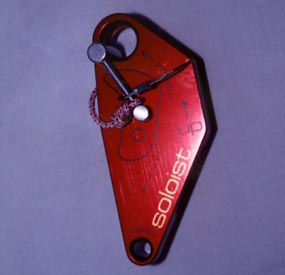
Here is what you could find on the Wren Industries web site when in production.
One can read: “The one tool for solo climbing. A directional cam allows rope to feed through automatically as the climber advances, yet locks solidly in a fall, without rope damage. The Soloist is suitable for lead climbing or top roping and you can also rappel with it. The Soloist comes with a detailed instruction manual which must be read and understood before using the device.
NOTE: This is not a device for novice climbers. It requires a strong understanding of advanced rigging techniques. The Soloist must be used with a chest harness because it will not lock when inverted.
Strength: 6,000 lbf (26.7 kN)
Weight: 11.3 oz. (321 g)
Price: $105”
Also this article from the April/May 1992 issue of Climbing Magazine: "Solo Games by Duane Raleigh The Rock Exotica Soloist ($100) is similar to the Solo Aid, but feeds rope out automatically, making it superior for free climbing. It is about twice the size of the Solo Aid, is heavier, and costs $20 more. This device also has a three-part construction and is assembled around the rope. Threading the rope properly and correctly positioning the unit between your sit and chest harness (a chest harness is mandatory for using the Soloist) takes practice, which is wisely done at home. When you are climbing, the Soloist glides smoothly along the rope, letting you do harder free moves than any of the knot belays or the Solo Aid. However, the device won’t catch upside-down or head-first falls. In situations where you might fall inverted, such as laybacks or roofs, you need to tie backup knots close to the Soloist or switch to the figure-8 belay. Aid climbers will find the Soloist more bane than boon. The unit tangles easily with an aid rack, and its hands-off operation isn’t an advantage since while aid climbing you are hanging on gear and always have a hand free. Toprope solo climbing is the Soloists’ real specialty and for this use we favored it over all other solo devices. It glides up the rope easily, locks securely when you weight it, releases easily when you want to resume climbing, stays out of your way because it rides above your waistline, is easy to back up, and quickly converts into a functional and controllable single- rope rappel device. The Soloist, like all solo-belay devices, works best on straight-up topropes set on vertical or less-than-vertical climbs. Overhanging and traversing routes are difficult to get back onto once you have fallen, and cause the device to drag hard because the rope pulls at an angle rather than running straight through the unit. We used the Soloist on 10-, 10.5- and 11-millimeter ropes, these being the sizes recommended by Rock Exotica, and found that thicker ropes produced only slightly more drag. For best toprope performance attach an empty pack or small rack to the bottom of the rope, which lets the Soloist slide up the rope easier."
Big problem was it does NOT stop your fall if you fall head first. This problem is shared by many popular systems today. A reliable backup system is mandatory. (as always anyway)
The manual (copy here) was all what a climber could find to learn LRS. It was an incredibly good base to start a safe LRS carreer!
I got my Soloist in 1996 exactly a year after I started climbing in a gym. I got lots of miles from it and it still runs strong!
Rope Solo – Landmark Event #6 – 1989 – Solo Aid Production by Rock Exotica

Here is what you could find on the Wren Industries web site when in production.
One can read: “Similar in design to the Soloist except that the Solo-Aid requires manual feeding of the rope through the device. Unlike the Soloist, the Solo-Aid will lock even when inverted, increasing its ability to catch a head first fall. The solo-Aid comes with a detailed instruction manual which must be read and understood before using the device.
NOTE: This is not a device for novice climbers. It requires a strong understanding of advanced rigging techniques.
Strength: 5,000 lbf (22.2kN)
Weight: 7.4 oz. (210 g)
Price: $84”
It DID stop your fall if you fall head first. It was lighter and more aforadable than the Soloist. BUT this device was mainly for aid climbing since it had to be fed by hand (not self-feeding). (see note!)
I do own a Solo-Aid today. But I push the time when I invest efforts to get the skills to climb with it. I invested time in the clove hitch and 15 other methods. Never the Solo-Aid. It just is not so attractive because it is not ideal for free climbing and I risk pinching my fingers 😉 . Kidding. All systems have their flaws!! Rather I cherrish the time when I will take the time 🙂 .
NOTE: If you read this far you MUST look at this video of Petr Špek Slanina LRSing free with the Solo-Aid. One of my all-time favorite videos!
The manual (copy here) was all what a climber could find to learn LRS. It was an incredibly good base to start a safe LRS carreer!
I got my Soloist in 1996 exactly a year after I started climbing in a gym. I got lots of miles from it and it still runs strong!
———————————————————————————————————————————–
If you’re interested in Top Rope Solo or Lead Rope Solo climbing, I encourage you to explore my online courses, which offer the most comprehensive information on the subject. (link below)
This is one of the articles about the 44 Rope Solo Landmark Events. I should unveil the full Timeline July 2024. These articles will be only available to my paying Patreons (any tier) or online course buyers for now.
Give yourself more freedom and purchase and explore my online courses here: https://blissclimbing.com/en/online-courses/
Encourage us through Patreon, buy any tier level on https://www.patreon.com/blissclimbing and receive articles, links, documents, etc. directly in your mailbox!!
Here is the version of the Rope Solo timeline for now. You will get an update with each new story as I unveil them ENJOY!


